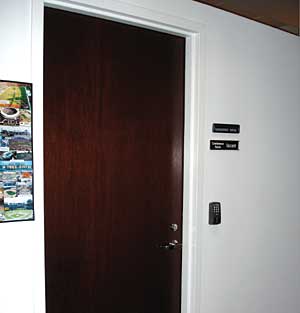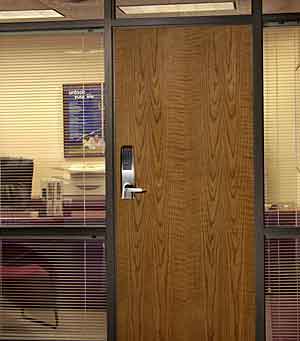Access Control: Delivering Security, Life Safety, and Convenience
Access Control Components
Locking hardware provides control over who enters a facility by limiting the number of access points. This funnels all building occupants and visitors through central doorways that can easily be monitored to keep out unauthorized individuals. Internal doorways can also be configured to allow access only to authorized personnel. There are many options available for accomplishing this task.
A mechanical lock and key system is the simplest from a technology standpoint, but requires extensive upkeep. Meticulous record keeping is needed to track all keys. If one key is lost or stolen, it will be necessary to look back in the records and determine which locks are accessible with the missing key. The cylinders on those locks then need to be replaced and new keys must be issued to anyone with access to those doors.
|
Key duplication is another concern, but but is not an issue when selecting a patented high-security key system that offers factory protection of key blanks. This means the manufacturer of the key system will not distribute key blanks without written permission from authorized facility personnel. Even if electronic hardware is used, a master key override is employed on most locking systems.
Electromechanical door controls, either stand alone or hardwired locksets, sidestep the key control issue and allow even greater levels of access control. Stand alone locks are battery powered, require no hardwiring, and, therefore, are generally less expensive to install. A stand alone lock can be operated by magstripe card, key fob, keypad, or a combination of card and keypad or fob and key pad. The locks can be interrogated for security purposes and programmed to allow varying levels of access privileges. Unless the locks offer wireless networking capabilities, however, most stand alone locksets on the market are unable to communicate directly with other building security controls.
|
Hardwired door hardware offers the ultimate in door control. A hardwired opening can be linked to a network, allowing user access privileges to be changed instantly. Important security tasks, interrogation of door locking hardware, changing user profiles, identifying possible security breaches and issuing lockdowns, can all be completed from a centralized computer. In addition, hardwired openings can be linked with the facility alarm controls. If a fire alarm is activated, the control panel will send a signal to automatically close all fire doors and bypass delayed egress exit devices. This versatility makes hardwired openings ideal for facilities that require tight control over security and life safety.
The type of hardware used will vary. Mechanical hardware will usually consist of mortise locks, cylindrical locks, and exit devices, while stand alone locks are typically available as mortise locks, cylindrical locks or exit devices. Electromechanical hardware will also include mortise locks, cylindrical locks, and exit devices, along with electric strikes, magnetic locks, keypads, card/proximity readers, automatic openers, and door position switches.











